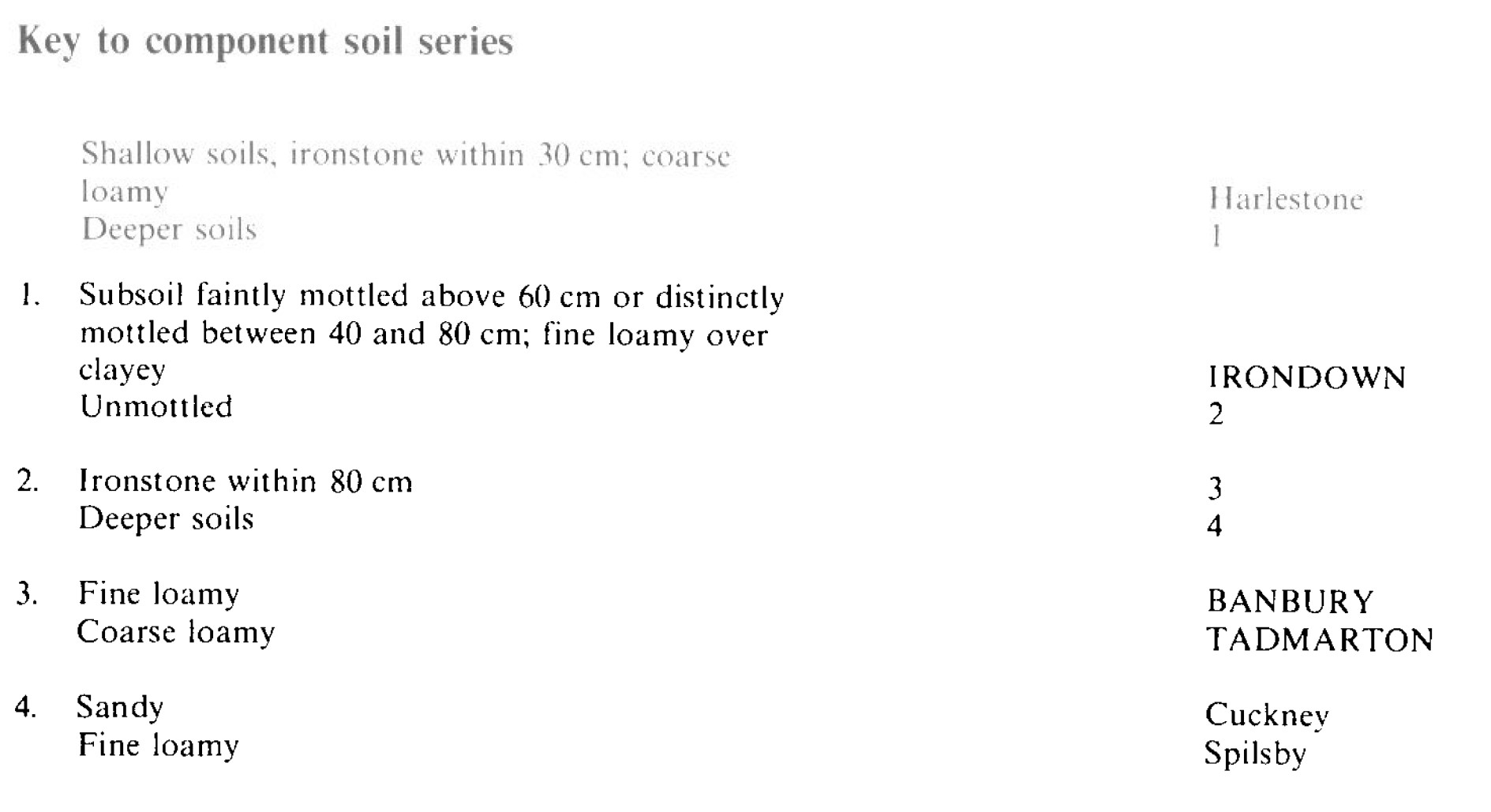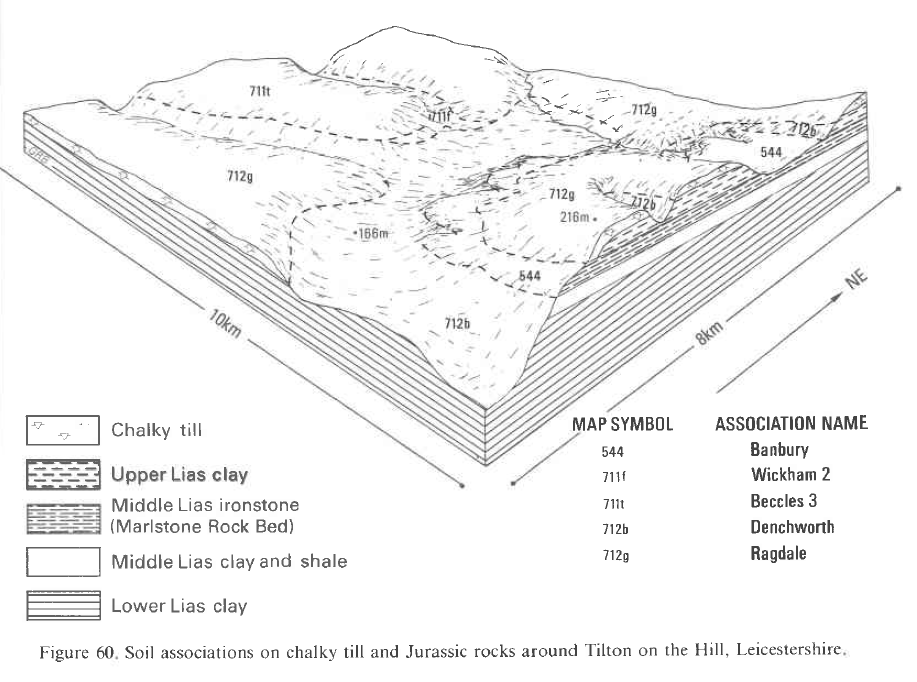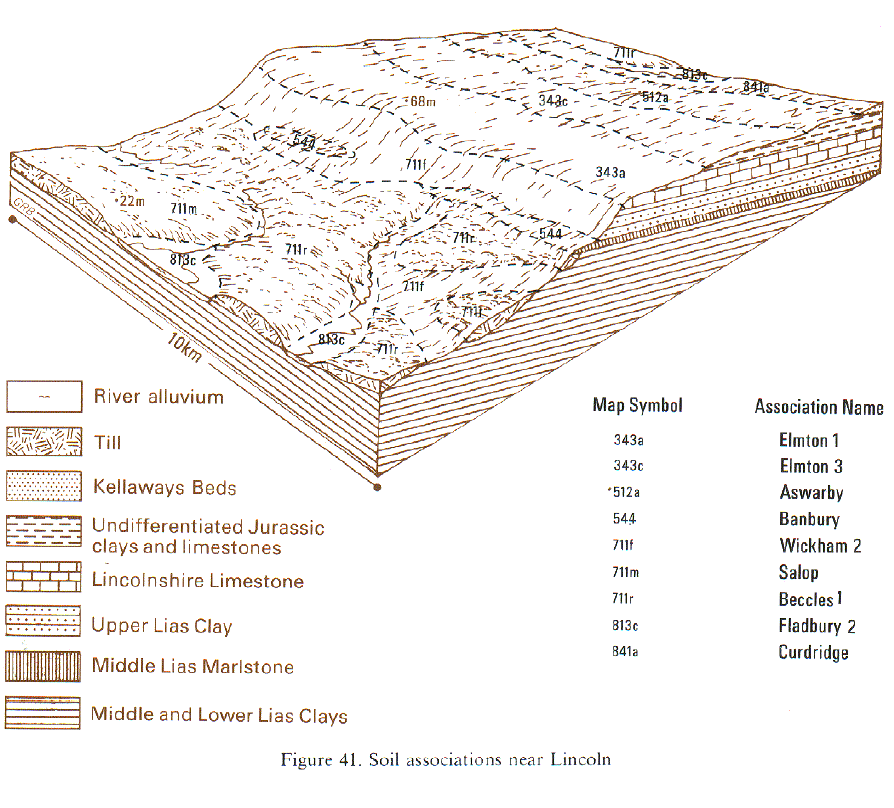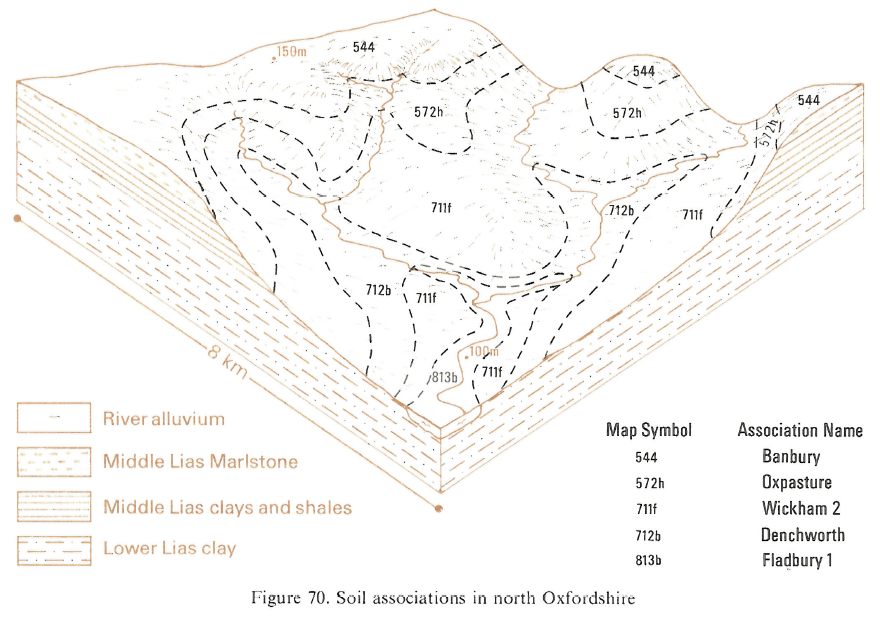
Soil Associations
0544 BANBURY
Soil and site characteristics
Well drained brashy fine and coarse loamy ferruginous soils over ironstone. Some deep fine loamy over clayey soils with slowly permeable subsoils and slight seasonal waterlogging.
Geology
Jurassic and Cretaceous ironstone
Cropping and Land Use
Winter cereals with short term grassland, some potatoes; permanent grassland on valley slopes; some sugar beet In Eastern Region.
Component soil series
| Subgroup | Series name | Percentage | WRB 2006 link |
|---|---|---|---|
| 5.44 | BANBURY | 50% | Eutric Chromic Endoleptic Cambisols |
| 5.44 | TADMARTON | 25% | Eutric Chromic Endoleptic Cambisols |
| 5.45 | IRONDOWN | 15% | Ruptic Chromic Endostagnic Cambisols |
Covers 712 km2 in England and Wales
Soilscapes Classification
| 7 |
Freely draining slightly acid but base-rich soils |
0544 BANBURY
Detailed Description
The Banbury association stretches in a wide discontinuous band from Nottingham to Oxford, with smaller areas north of Scunthorpe and in Dorset and Wiltshire. The principal soils, Banbury and Tadmarton series, are stony, well drained, fine and coarse loamy ferritic brown earths resting on shattered ironstone at 50 to 70 cm depth. The main associated soils, Irondown series, are fine loamy over clayey stagnogleyic ferritic brown earths. There are also a few patches of Harlestone, Oxpasture and Cuckney soil.
The association occurs on interfluves and valley benches on the Northampton Sand and Middle Lias Marlstone in the east of the region between Melton Mowbray and Newark-on-Trent, Oakham and Market Harborough, and between Priors Marston and Long Compton. Around Oakham, the Middle Lias Marlstone Rock Bed contains limestone bands giving small patches of Aberford soils. Bands of fine silty and clayey mudstones locally give rise to Oxpasture soils. Tadmarton soils are a common constituent particularly east of Leicester on high ground. Cuckney soils occur with Tadmarton soils on local patches of sand especially on moderately steep slopes. Harlestone soils are restricted to eroded sites. On the edges of the map separates, often on steep slopes, where thin Head derived from the ironstone overlies clay shale, Irondown soils are dominant and there are some Oxpasture and Wickham soils. Near Shotteswell, Ratley and Upton the underlying Middle Lias contains silty and fine loamy bands giving Atrim soils.
The association covers about 270 km² in Northamptonshire between Stamford and Aynho, and 53 km² in Lincolnshire mostly between Scampton and Grantham. It occurs on hilltops and valley benches on Cretaceous ironstone, Northampton Sand and Middle Lias Marlstone. Near Brockhall, Northamptonshire, the Middle Lias Marlstone contains limestone bands that give patches of Aberford series which also occurs in Lincolnshire in the valleys of the limestone dipslope. In Lincolnshire, Spilsby soils with ironstone below 80 cm depth occur.Tadmarton soils are a common constituent , particularly around Northampton on high ground. Cuckney soils occur with Tadmarton soils on local patches of sand. Harlestone soils are restricted to eroded sites. On the edges of the map separates, often on steep slopes, where thin ironstone Head overlies clay shale, Irondown soils are dominant and here there are some Oxpasture and Wickham soils. The association occurs mainly on the dipslopes of Frodingham ironstone, a formation within the Lower Lias, between 8 to 60 m O.D. in several small patches between Scunthorpe and Winteringham.
In South East England, the association is developed mainly on Jurassic ironstone and occurs on hilltops on the Northampton Sand and Middle Lias Marlstone around Banbury. Here, in the Marlstone, bands of fine silty and clayey mudstone give Oxpasture soils, and Harlestone soils are found on the steeper eroded sites. To the south-east of Oxford on Wealden ironstone the soil pattern is varied but Tadmarton series is dominant with Fernhill and Standhill soils as the main associates.
Soil Water Regime
Banbury and Tadmarton soils are well drained (Wetness Class I). Water drains rapidly into the porous bedrock and no drainage treatments, apart from occasional subsoiling to break ploughpans, are required. Irondown soils have slowly permeable subsoils impeding downward water movement and topsoils become waterlogged after prolonged periods of winter rainfall (Wetness Class III). Surplus water flows laterally above the clay subsoil and in places forms springs. Most soils in the Banbury association readily absorb excess winter rainwater.
Cropping and Land Use
Most of the land is arable, mainly under autumn sown cereals and ley grassland with potatoes and some sugar beet on less stony land. On steep slopes, permanent grassland is common. Because of their large sand content and weak topsoil structure, Tadmarton soils cap and erode readily on bare or sparsely vegetated fields, especially where organic matter contents are small. The timing of cultivations is generally flexible and there are opportunities for winter fieldwork after rain-free periods of about a week. On the wetter Irondown soils, timing is more critical.
Free drainage and level or gently sloping sites make Banbury and Tadmarton soils suitable for direct drilling, except where topsoils are very stony. The slowly permeable subsoils of Irondown series can cause surface ponding during wet weather leading to compaction. The soils are slightly droughty for most crops but moderately droughty for grass. Potatoes will benefit from irrigation especially in dry years. Soil water reserves, though usually adequate for cereals are insufficient for satisfactory grass growth and yields are reduced. Ley grassland is commonly used as a break in the rotation and cattle and sheep rearing are an integral part of the farming system. Intensity of pasture use is not influenced by poaching risk, which is slight on the Banbury and Tadmarton series, but by moisture reserves insufficient to sustain growth in most summers. These dry soils allow the out-wintering of stock and the ground warms up in early spring.
The soils are naturally acid. On Banbury series crops often suffer from magnesium deficiency and so it is best to use rnagnesian limestone to correct acidity. Phosphorus levels are varied and the status depends on past management. Marked responses to phosphorus fertilizers are unlikely in well managed grassland or cereals. Available potassium is inherently low and annual applications are needed for optimum cropping.
0544 BANBURY
Distribution Map
 |
Note that the yellow shading represents a buffer to highlight the location of very small areas of the association.
Keys to component soil series
Eastern Region
 |
Midlands
 |
South Eastern Region
 |
Typical Landscapes
South Western Region
 |
Midlands
 |
Eastern Region
 |
Eastern Region
 |
Eastern Region
 |
Eastern Region
 |
Northern Region
 |
South Eastern Region
 |
All information Copyright, Cranfield University © 2024
Citation: To use information from this web resource in your work, please cite this as follows:
Cranfield University 2024. The Soils Guide. Available: www.landis.org.uk. Cranfield University, UK. Last accessed 19/04/2024
